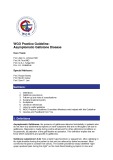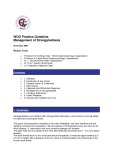WGO Practice Guideline Management of Strongyloidiasis
28 October 2004
Review Team
• Professor M. Farthing (Chair - World Gastroenterology Organisation) • Professor S. Fedail (World Gastroenterology Organisation) • Dr. L. Savioli (World Health Organisation) • Dr. D.A.P. Bundy (World Bank) • J.H. Krabshuis (Highland Data)
Contents
• 1. Definition • 2. Introduction & Key Points • 3. Disease Burden & Endemicity • 4. Risk Groups • 5. Diagnosis and Differential Diagnosis • 6. Management of Strongyloidiasis • 7. Literature References • 8. Useful Websites • 9. Queries and Feedback from you
1. Definition
Strongyloidiasis is an infection with Strongyloides stercoralis, a round worm occurring widely in tropical and subtropical areas.
The genus Strongyloides is classified in the order Rhabditida, and most members are soil- dwelling microbiverous nematodes. Fifty-two species of Strongyloides exist, but most do not infect humans. S. stercoralis is the most common pathogen for humans. The adult male worm is passed in the stool after fertilizing the female worm – it is not a tissue parasite. The adult female worm is very small and almost transparent. It measures approximately 2.2– 2.5 mm in length with a diameter of 50 µm; it lives in tunnels between the enterocytes in the human small bowel.
Strongyloides stercoralis is different from all other soil transmitted helminthic infections because the female worm can reproduce by parthogenesis within the human host. Depending on the host immune response, this can lead to autoinfection and hyperinfection.
Terminology:
"autoinfection": the process that enables the parasite to survive very long in the human host; mostly asymptomatically.
"Hyper-infection": the process of intense auto-infection; the phase in which third stage larvae can be found in fresh stools.
"Disseminated infection": the outcome of hyperinfection: larvae can be found anywhere, particularly in sputum and skin.
Figure 1. Strongyloides stercoralis first stage larvae
Strongyloides stercoralis first-stage larva (L.) preserved in 10% formalin. The prominent genital primordium in the mid-section of the larva (black arrow) is readily evident. Note also the Entamoeba coli cyst (white arrow) near the posterior end of the larva.
There are two important stages in the life cycle of the worm, the rhabditiform stage and the filariform stage.
Figure 2. Hookworm and Strongyloides Larvae [Adapted from Melvin, Brooke, and Sadun, 1959]
2. Introduction & Key Points
2.1. Pathophysiology
Strongyloides stercoralis has a unique and complex life cycle.
The drawing below - taken from the US CDC website at outlines the unique routes of S. stercoralis replication.
Figure 3. Strongyloides stercoralis life cycle
The Strongyloides life cycle is more complex than that of most nematodes with its alternation between free-living and parasitic cycles, and its potential for autoinfection and multiplication within the host. Two types of cycles exist:
Free-living cycle: The rhabditiform larvae passed in the stool can either molt twice and become infective filariform larvae (direct development) or molt four times and become free living adult males and females that mate and produce eggs from which rhabditiform larvae hatch. The latter in turn can either develop into a new generation of free-living adults or into infective filariform larvae. The filariform larvae penetrate the human host skin to initiate the parasitic cycle.
Parasitic cycle: Filariform larvae in contaminated soil penetrate the human skin, and are transported to the lungs where they penetrate the alveolar spaces; they are carried through the bronchial tree to the pharynx, are swallowed and then reach the small intestine. In the small intestine they molt twice and become adult female worms. The females live threaded in the epithelium of the small intestine and by parthenogenesis produce eggs, which yield rhabditiform larvae. The rhabditiform larvae can either be passed in the stool (see "Free- living cycle" above), or can cause autoinfection. In autoinfection, the rhabditiform larvae become infective filariform larvae, which can penetrate either the intestinal mucosa (internal autoinfection) or the skin of the perianal area (external autoinfection); in either case, the filariform larvae may follow the previously described route, being carried successively to the lungs, the bronchial tree, the pharynx, and the small intestine where they mature into adults; or they may disseminate widely in the body. To date, occurrence of autoinfection in humans with helminthic infections is recognized only in Strongyloides stercoralis and Capillaria philippinensis infections. In the case of Strongyloides, autoinfection may explain the possibility of persistent infections for many years in persons who have not been in an endemic area and of hyperinfections in immunocompromised individuals. The current record is 65 years.
Alternative theories have been suggested [1], for example the simple idea that larvae may migrate directly from the skin to the duodenum through the connective tissues, however no direct evidence to support such hypotheses is available to date.
2.2. Relationship with HIV/AIDS
HIV/AIDS facilitates strongyloidiasis.
Strongyloidiasis is not an important opportunistic infection associated with AIDS but it is an opportunistic infection associated with the human T-lymphocyte virus [7].
The literature cited below reviews evidence of interaction. The key issue for a clinician is to be very careful indeed as immunosuppression may facilitate strongyloidiasis becoming hyperinfective/disseminating.
Strongyloidiasis in immunosuppressed people can lead to hyperinfection
Table 1. Strongyloidiasis in relation to HIV/AIDS.
General comment: strong evidence of immunological interaction during co-infection by the soil-transmitted helminth S. stercoralis and a retrovirus that causes leukaemia, as well as immune disorder diseases, in humans (human T-cell lymphotropic virus type-1 [HTLV-1]), has been reported from Brazil, Jamaica, Japan and Peru (Robinson et al., 1994; Hayashi et al., 1997; Neva et al., 1998; Gotuzzo et al., 1999 and Porto et al., 2001). These findings support the possibility that a similar situation may occur during co-infection by helminths and HIV-1, which is also an immunosuppressive retrovirus.
Strongyloidiasis and immunosuppressed people
There are many patients with rheumatoid arthritis and bronchial asthma in the tropics who are on long term steroids. Patients can purchase steroids directly from pharmacies – they are cheaper than most NSAIDS (which lead to immune suppression) .
2.3 Mortality and Morbidity
Acute strongyloidiasis is often asymptomatic and can remain hidden for decades. Immunocompetent patients often have asymptomatic chronic infections causing negligible morbidity.
Clinically apparent strongyloidiasis can lead to cutaneous, gastrointestinal and pulmonary symptoms.
Severe disseminated strongyloidiasis has a high mortality rate of up to 87%.
3. Disease Burden and Endemicity
Strongyloides stercoralis is endemic in the tropical and subtropical regions and infects up to one hundred million people. It is widespread also in Eastern Europe and in the Mediterranean region.
An interesting table is produced by Siddiqui [7].
Table 2. Recent data on Strongyloides stercoralis prevalence in some developing nations.
Abidjan
1001
1.4
Argentina
36
83.3
Argentina
207
2.0
Brazil
200
2.5
Brazil
900
13.0
Ethiopia
1239
13.0
Guinea
800
6.4
Honduras
266
2.6
Israel
106
0.9
Kenya
230
4.0
Laos
669
19.0
Mexico
100
2.0
Nigeria
2008
25.1
Romania
231
6.9
Sierra Leone
1164
3.8
Location No. of specimens examined Specimenspositive for S. stercoralis, %
Sudan
275
3.3
Thailand
491
11.2
Figure 4. Geographic distribution of Strongyloidiasis.
S. stercoralis is endemic in the tropics and subtropics and infects as many as 100 million people. It is endemic in Southeast Asia, Latin America, Sub-Saharan Africa and in the South Easter United States.
4. Risk groups
Patients with AIDS and HIV and those on immunosuppressive drugs are at an increased risk
•
Risk factors for severe strongyloidiasis:
• Patients with altered cellular immunity • Human T-cell leukemia virus type 1 infection • Neoplasms, particularly hematologic malignancies (lymphoma, leukemia) • Organ transplantation (kidney allograft recipients) • Collagen vascular disease • Malabsorption and malnutrition states • End-stage renal disease • Diabetes mellitus • Advanced age • HIV-1 infection • Travellers to and from endemic areas • Prisoners • Local factors, diverticular and blind loops (persistent Strongyloides stercoralis in a
Immunosuppressive medications (especially corticosteroids, also tacrolimus and chemotherapeutic agents)
blind loop of the intestine)
5. Diagnosis and Differential Diagnosis
5.1 Physical Signs and Symptoms
Acute
Itch (usually on feet)
• Larva currens (most characteristic sign) • • Wheezing/cough/low grade fever • Epigastric tenderness • Diarrhea/nausea/vomiting
Chronic (usually the result of auto-infection)
Intermittent diarrhea (alternating with constipation)
• Larva currens (most characteristic sign) • Epigastric tenderness • Asymptomatic/vague abdominal complaints • • Occasional nausea and vomiting • Weight loss (if heavier infestation) • Recurrent skin rashes (chronic urticaria)
Severe(usually as a result of hyper or disseminated infection)
Insidious onset
Severe abdominal pain, nausea and vomiting
Stiff neck, headache,confusion (meningismus) Skin rash (petechiae, purpura) Fever, chills
• • Diarrhea (occasionally bloody) • • Cough, wheezing, respiratory distress • • •
Table 3 - Strongyloidiasis physical signs and symptoms
The key to diagnosing strongyloidiasis is to have an index of suspicion - a diagnosis of strongyloidiasis can only be made for certain when the worm is identified in stool. Because of a low worm burden and because of its ability to replicate within the host it is often impossible to diagnosis the worm in one analysis only. Serial analysis over a number days is necessary. A white blood count (WBC) is important as is eosinophilia (high in 50% of patients).
The issue of eosinophilia is confusing: it is a most helpful sign in simple uncomplicated infections and mostly absent in disseminated strongyloidiasis.
5.2 Diagnostic Techniques
Figure 5. Different diagnostic staining and culture techniques for Strongyloides Stercoralis: A, Lugol iodine staining of the rhabditiform larva in stool. This is the most commonly used procedure in clinical microbiology laboratories. A single stool examination detects larvae in only 30% of cases of infection. Scale bar = 25 µm. B, Human fecal smear stained with auramine O, showing orange-yellow fluorescence of the rhabditiform larva under ultraviolet light. Routine acid-fast staining of sputum, other respiratory tract secretions (eg bronchial washings), and stool may also serve as a useful screening procedure. Scale bar = 25 µm. C, Agar plate culture method. Motile rhabditiform larvae and characteristic tracks or furrows, which are made by larvae on the agar around the stool sample. This diagnostic method is laborious and time-consuming (2 3 days) but is more sensitive than other procedures (eg wet mount analysis) for the detection of larvae in faeces. Tracks are marked (arrows and T). S, stool sample on agar plate; L, larva or larvae. Scale bar = 250 µm. D, Gram stain demonstrating S. stercoralis filariform larvae (FL). Gram staining of a sputum sample is an excellent tool for diagnosing pulmonary strongyloidiasis. Scale bar = 250 µm.
There are a number of diagnostic procedures:
• String Tests • Duodenal aspiration • • Repeated examination of stool
Immunodiagnostic tests (IFA, IHA, EIA,ELISA)
All have some advantage (see here), but overall the repeated examination of stool is the best method.
• Baermann funnel technique (still regarded as the gold standard) • Directly (dissection microscopy) • Direct smear of faeces in saline-lugol iodine stain • After concentration (formalin-ethyl acetate) • After culture by the Harada-Mori filter paper technique • Nutrient agar plate cultures (not for case-management/limited to epidemiological
There are several techniques to identify larvae in stool.
studies)
The use of these tests in addition to direct microscopy of fecal smears will depend on local availability of resources and expertise.
The most important test for demonstrating S.stercoralis remains the repeated examination of stool over a number of consecutive days.
Stool analysis for strongyloides using the Baermann funnel technique is the best way to diagnose Strongyloidiasis
Baermann Funnel Technique The basic Baermann funnel technique which has a large number of modifications utilizes a glass funnel with a wire mesh basket nested on top. A piece of rubber tubing is slipped over the stem and sealed with a clamp. The funnel is filled with water to a level that will cover soil or plant tissue to be placed in the basket at the top of the funnel. A piece of tissue is used to line the basket and minimize the amount of soil that passes through. Nematodes leave the soil or plant tissue, pass through the tissue liner, and accumulate at the constriction of the tube created by the clamp. After a period of time, the clamp is loosened slightly to allow a few milliliters of solution to pass into a container, leaving a fairly clean solution to view under a microscope. Laboratories have developed variations for every component of this technique.
• Paper toweling • Fine mesh screen (metal) • Small wire basket (or plastic food basket) • Funnel • Tubing (that fits the base at the bottom of the funnel) • Clamp • Microscope, slides, cover slips and petroleum jelly (for observing specimens)
MATERIALS
PROCEDURE
1. Separate the soil in each sample by passing it through the fine mesh screen. 2. Once the larger chunks have been broken down, spread the sample on a paper tissue. The soil should form a layer about 1-cm thick.
3. Wrap up the soil within this tissue and place it within the wire basket or plastic fruit basket. 4. Slip a hose with a clamp onto the neck of a large funnel. Position the basket and soil in the funnel. SEE DIAGRAM
Figure 6.
5. Make sure that the clamp is set on the hose. Fill the funnel with enough water so that the bottom of the soil is positioned beneath the surface of the water. 6. Leave undisturbed for 2-3 days. You may have to refill the funnel to replace water lost to evaporation.
7. During this time, active nematodes will move out of the soil and into the water. They'll fall to the bottom of the funnel and collect in the tube. To retrieve these specimens, release the clamp allowing water to flow through the hose into a collection beaker.
• Place stool on agar plate • Seal plate to avoid accidental infection • Store plate for 2 days at room temperature • Larvae crawl over surface and carry bacteria with them, creating visible tracks • Examine plates to confirm larvae • Wash with 10% formalin and collect larvae by sedimentation
Agar plate cultures are performed as follows:
Repeat this procedure up to 6 or 7 consecutive days because of low parasite load and irregular output of larvae in many patients. Tests have shown the agar plate method is
superior over a) direct smear, b) formalin-ether sedimentation technique, c) filter paper method. The Agar-plate method is not however available globally - sometimes only in the large town and teaching hospitals only.
Endoscopy shows signs characteristic of inflammation of the duodenal mucosa. A strict observation of endoscope disinfection procedures is important as unsterilized endoscopes can transmit the worm.
5.3 Differential Diagnosis
•
There are many conditions producing similar symptoms - Consider:
• • • Functional abdominal disorders • Drugs (NSAIDS, gold)
Intestinal Infections (amebiasis, bacterial colitis, shigella, campylobacter, yersinia, clostridium difficile) Inflammatory bowel disease Irritable bowel syndrome
The key diagnostic element is to identify the parasite. This is not easy because the worm load is usually low and a number of stool tests need to be done to arrive at a conclusive diagnosis. The chances of finding the worm are proportionate to the number of occasions in which the faeces is examined.
6. Management of Strongyloidiasis
6.1 Uncomplicated Strongyloidiasis
The treatment of strongyloidiasis is difficult because in contrast with other helminthic infections the strongyloides worm burden must be eradicated completely. Complete eradication is difficult to ascertain because of the low worm load and irregular larval output. A true cure cannot be pronounced on the basis of negative follow-up stool examination alone.
A single stool analysis for Strongyloides stercoralis was found to be negative in up to 70% of known cases with strongyloides infection.
Drug Name
Ivermectin (Stromectol, Mectizan) -- DOC for acute and chronic strongyloidiasis. Binds selectively with glutamate-gated chloride ion channels in invertebrate nerve and muscle cells, causing cell death. Half- life is 16 h; metabolized in liver.
Adult Dose
200 mcg /kg /d PO for 2 d; may repeat course in 14 d
Pediatric Dose
Administer as in adults if > 2 yearsIf <2 years: 200 mg/d PO for 3 d
Contraindications Documented hypersensitivity; do not use in first trimester of pregnancy and avoid use until after
delivery, if possible
Interactions
None reported
Pregnancy
Safety for use during pregnancy has not been established.
Precautions
Treat mothers who intend to breastfeed only when risk of delayed treatment outweighs possible risks to newborn caused by ivermectin excretion in milkRepeat courses of therapy may be required in patients
Table 4. Preferred medication for Strongyloidiasis [taken from here]
who are immunocompromisedMay cause nausea, vomiting, mild CNS depression, and drowsiness
Use a single dose of Ivermectin 200 µg /kg to treat strongyloidiasis
A single dose of Ivermectin at 200 µg /kg bodyweight is the drug of choice for the treatment of uncomplicated strongyloidiasis although there is little evidence to support its use in children. Currently dosing in children is estimated by height rather than weight using a cm marked pole.
Ivermectin is available in 3 and 6mg tablets.
A follow-up stool examination after therapy can confirm results. In chronic cases ivermectin can be given every 3 months until stools are negative in at least three subsequent tests.
Albendazole can also be used as an alternative.
6.2. Hyperinfection or disseminated infection
The terms are used interchangeably and refer to a very high and rapid spread of the infection - usually in immunosuppressed patients and often associated with corticosteroid treatment.
Hyperinfection carries a high risk of gram-negative septicaemia and thus broad spectrum antibiotics are usually given, especially to prevent bacterial meningitis.
6.3. Prevention
Infection is prevented by avoiding direct skin contact with soil containing infective larvae. People at risk - especially children - should wear footwear when walking on areas with infected soil. Identify patients at risk and perform appropriate diagnostic tests before they begin mmunosuppressive therapy.
Persons in household contact with patients are not at risk for infection. The proper disposal of human excreta reduces the prevalence of strongyloidiasis substantially.
No accepted prophylactic regimen exists and no vaccine is available.
6.4. Prognosis
Acute and chronic strongyloidiasis have a good prognosis. However, untreated infection can persist for the remainder of the patient's life because of the autoinfection cycle. A patient's prolonged absence from an endemic area is no guarantee of freedom from infection.
Severe disseminated infection is commonly a fatal event, and it is often unresponsive to therapy.
7 Literature References
1. Grove DI; Strongyloidiasis: a conundrum for gastroenterologists; GUT 1994, 35:437-440 Pubmed-Medline
2. Grove DI, Human Strongyloidiasis; Adv Parasitol 1996; 38:251-309 Pubmed- Medline
3. Dickson R; Awasthi S; Demellweek C; Williamson P; Antihelminthic drugs for treating worms in children: effects on growth and cognitive performance; Cochrane Database of Systematic Reviews 2003 VOL 1 4. The BMJ correspondence criticising this plus author's reply. BMJ 2000; 321; p 1224;11 November Link to BMJ 2000;321:1224 Full Text Link 5. Siddiqui AA, Berk SL, Diagnosis of Strongyloides stercoralis; Clinical Infectious Diseases; 33; 2001;1040-1047 Full Text Link.
6. Albonico M , Crompton DW, Savioli L; Control strategies for human intestinal nematode infections. Adv Parasitol 1999;42-277-341 Pubmed-Medline 7. D.W.T. Crompton, D. Engels. L Savioli, A. Montresor, M. Neira. Preparing to
control Schistosomiasis and Soil transmitted helminths in the twentyfirst century. Acta Tropica; 16;2-3 pp 121-347; May 2003-08-16
8. Prevention and Control of Schistosomiasis and soil-transmitted helminthiasis; Report of a WHO Expert Committee; WHO technical Report series No 912 ; Geneva 2002 Pubmed-Medline 9. Savioli L, Albonico M, Engels D, Montresor A. Progress in the prevention and
control of schistosomiasis and soil-transmitted helminthiasis. Parasitol Int. 2004 Jun;53(2):103-13 Pubmed-Medline
8. Useful Websites
1. The US CDC publishes a free information sheet on strongyloidiasis at:
http://www.dpd.cdc.gov/dpdx/HTML/Strongyloidiasis.htm 2. The American Sociey of Tropical Medicine and Hygiene: http://www.astmh.org/index2.html
3. Royal Society of Tropical Medicine and Hygiene: http://www.rstmh.org/ 4. EMedicine on Strongyloidiasis
http://www.emedicine.com/derm/topic838.htm http://www.emedicine.com/ped/topic2161.htm http://www.emedicine.com/med/topic2189.htm 5. World Health Organisation (WHO), 1994. Bench Aids for the diagnosis of intestinal parasites, Geneva.
6. World Health Organisation (WHO), 1998a. Guidelines for the evaluation of soil- transmitted helminthiasis and schistosomiaisis at community level. A Guide for Managers of Control Programmes. WHO/CTD/SIP/98.1, Geneva. 7. World Health Organisation (WHO), 1999. Monitoring helminth control programmes. A guide for Managers of Control Programmes (II). WHO/CTD/SIP/99.3, Geneva.




















